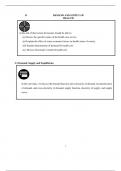D DEMAND AND SUPPLY OF
HEALTH
At the end of this lecture the learner should be able to:
Discuss the specific nature of the health care service
Explain the effect of some economic factors on health status of society.
Explain determinants of demand for health care
Discuss Grossman‟s model of health care
2.1 Demand, Supply and Equilibrium
In this sub-topic, we discuss the demand function, price elasticity of demand, incomeelasticity
of demand, and cross-elasticity of demand; supply function, elasticity of supply, and supply
curve.
-
1
, a) Demand
- In order to use scarce resources as efficiently as possible, an efficient information system is
required to bring together the values of the alternative uses of resources (products) with their
production cost, and to co-ordinate the many decisions of consumers and producers.
- The price system, although imperfect, attempts this difficult task and plays a central role in
economic analysis.
- It influences many health and health care programmes either directly or indirectly (e.g.
through markets for personnel, drugs etc.).
- It is thus important to consider the workings of the price system, through an examination of
demand and supply.
- In economics, the quantity of a particular good demanded is seen as a variable determined
by a range of factors.
- The demand function summarizes this relationship:
Qd = f (P, RP, Y, T, ...)
- The quantity demanded (Qd) is a function of the price of the good (P); the prices of other
related goods (RP); income (Y); and the organizational and institutional structure of society
and preferences and tastes of individuals (T) which will depend on many socioeconomic and
cultural factors.
- Of these, prices and incomes are the most useful for theoretical analysis.
- The demand function can represent the demand of an individual, or of all individuals
demanding a particular good - in which case it is simply the sum of individual demands.
- The relationship between demand and price is often portrayed as a demand curve (Figure 2).
- It illustrates how much would be demanded at each price.
- For most goods, more is bought as the price falls and so the demand `curve will slope
downwards.
- In using a two-dimensional drawing of the demand curve it is assumed that the other factors
(RP, Y,T) remain constant. This helps to clarify different aspects of demand, but modern
econometric techniques allow more sophisticated estimation of the impact of the different
variables on demand.
Figure 2: Demand Curve
P
0
Quantity
2
, - It is also important to know about the responsiveness of demand to changes in any of the
variables.
- Responsiveness is measured by economists and referred to as the elasticity of demand; it is
reflected in the shape of the demand curve.
- Price elasticity of demand is measured by expressing the percentage change in quantity
demanded (Qd) as a proportion of the percentage change in price (P).
% Change in Qd
=
d % Change in P
- If the percentage change in Qd is greater than the percentage change in price the demand for
a good is elastic, Ed > 1.
- If the percentage change in quantity demanded changes by less than the percentage change
in price (Ed < 1) the demand is inelastic.
- If the percentage change in price evokes a similar change in percentage quantity demanded
then the demand is unitary elastic, (Ed = 1).
- Elasticity will depend upon the ease with which goods can be substituted for one another.
- Income elasticity of demand measures the response in quantity demanded (Qd) which arises
from changes in income (Y).
-
% Change in Qd
=
d % Change in Y
- Cross-elasticity of demand measures the response in quantity demanded of good A (Qda) which
arises from changes in the prices of other goods or services (Pb).
% Change in Qda
AB =
% Change in Pb
- It measures the degree of association amongst goods, i.e. whether they substitute or
complement (need to be used with) each other.
b) Supply
- In economics, supply is used in a sense symmetrical with demand.
- The quantity of a good that producers offer for consumption is seen as determined by certain
economic variables, of which the most important is the price at which the good can be offered.
- The supply function relates the quantity supplied to the variables likely to affect it.
Qs = (P, RP, C, RC, T,........)
- The quantity supplied (Qs) is some function of the price of the good (P), relative prices (RP), costs
(C), relative costs (RC), and tastes (T) which will include socioeconomic and cultural factors.
- The supply curve (Figure 3) shows the relationship between price and the quantity supplied.
- It will normally slope upwards indicating that more will be supplied if prices rise.
3




